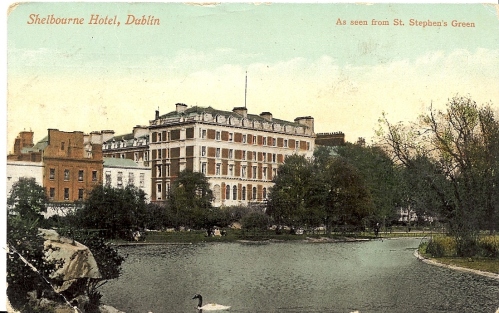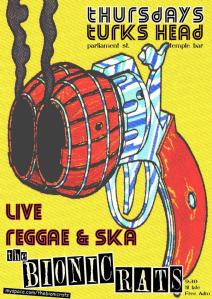(Once a month the three writers behind ComeHereToMe, joined by a small group of friends, visit five Dublin pubs and then write about their experiences. A different person each month picks the five pubs and they make sure not to give away any details. What fun.)
January was my month and I had picked the pubs carefully:
• Hartigan’s (For its links to UCD.)
• The Baggott Inn (For its links to Irish rock music history.)
• The Horse show bar in The Shelbourne Hotel (For its sheer beauty and history.)
• The International (For its importance in the history of Irish comedy.)
• Neary’s (For family links. This was the only pub in Dublin my grandmother ever entered ‘because of their sandwiches’.)
Out of the original five, on the day itself, three were closed. For future reference, don’t pick the Sunday after New Year’s Eve for a pub crawl in Dublin City. Things aren’t back to normal yet.
I chose the Royal College of Surgeons at 1 Saint Stephens Green as the meeting point, hoping to throw people off as to where we were going. The location meant that we just as easily could have made our way down to Camden Street or Dawson. The RSCI is also a building of great historical significance, namely the role it played in the 1916 Easter Rising, as well as the fact that it was built on a old Quaker burial ground.
At 4:32pm approximately, the five us began our January Pub Crawl cautiously making our way across the icy pavements towards Leeson Street, stopping at 68 St. Stephen’s Green, – ‘Newman House’. I announced to the group that this would be our only stop of a historical nature during the day before telling them the story of the Whaley family who built the house, their son Thomas ‘Buck’ Whaley and a dare devil bet involving a horse, a carriage and a first floor window that occurred sometime in the 1780s.
As we turned the corner, I was taken by surprise to see that Hartigan’s was closed. Undaunted by this initial set back, we crossed the road to Hourican’s, the pub that sits directly opposite. This is one of those forgotten pubs, one that thousands of people pass on their bus everyday, but very few venture into. The pub itself was quite pleasant. If I remember correctly, it had a lovely wooden interior decorated with a few more ‘Irish street signs’ and old advertisements than was necessary. The barman was extremely friendly, offering to bring us down our drinks. We had a lovely pint, a chat and then were on our way.
As I said, I had hoped to bring the gang down to The Baggott Inn next. Though I’ve heard it’s lost all its charm, no one can deny its important connection to the development of Irish punk and new wave in the late 1970s and early 1980s. It was not to be. The doors were firmly locked.
So instead we had to skip ahead to The Shelbourne. One of my favourite buildings in Dublin, I don’t think I need to argue its historical significance. The Shelbourne has stood over the Green since 1824 and played an important role in the 1916 Rising and the drafting of the Irish Constitution in 1922, which occurred in Room 112.
My favourite historical anecdote about the hotel dates from a little earlier. In 1911, Adolf Hitler’s half brother, Alois Hitler Jr., worked as a waiter in the hotel. During his time in the city, he met a Clondalkin woman called Bridget Dowling. They eloped to London, later having a child called William Patrick “Paddy” Hitler who only passed away in 1987.
I had wanted to visit the Horse Shoe bar (rumoured to have been where The Chieftains formed) but unfortunately it was closed. Instead we had to visit the Shelbourne’s new ‘No. 27’ bar. Though by now a clichéd term, it was fitting to mutter “recession, what recession?” while walking through the crowd. With eyes definitely on the five young males who were looking very out of place, we didn’t savor our pretty average pints and were soon making our way out of the revolving doors.
Knowing that I had now one pub extra to add to our tour, I took my uncle’s advice and chose The Bailey. I’ll say more about its history than our visit there. Once a pub of literary renown, it has been in business since 1837. Charles Parnell was once a regular patron, as was James Joyce, Oscar Wilde and George Bernard Shaw. Later Arthur Griffith was the centre of a group that met there including Oliver St. Gogarty, Seamus O’Sullivan (poet and editor of The Dublin Magazine), Padraic Colum (poet and dramatist) and James Stephens (novelist).
In the 1950s, it became the regular haunt of Brendan Behan, Liam O’Flaherty and Brian O’Nolan (Flann O’Brien). At the time, the owner of The Bailey, John Ryan, was an editor and publisher. He was the founding editor of Envoy (1949-51), a “short lived but important” literary magazine. During the first half of the 1970s, he edited the Dublin Magazine and was secretary of the James Joyce Society of Ireland.
“It was also the site of the door of 7 Eccles Street, the home of James Joyce’s protagonist from Ulysses, Leopold Bloom. The door was presented to the pub and publicly unveiled on June 16, 1967, by poet Patrick Kavanagh who had saved it from a renovator’s axe” – Brian Thomsen
In the 1980s, it became the haunt of a whole new generation of poets and writers – Phil Lynott and Thin Lizzy, Bono and U2, Bob Geldof and The Boomtown Rats, Philip Chevron and The Radiators from Space and Sinead O’Connor.
It has since lost all of its charm. In 1995, the pub was gutted and sold to the Thomas Read Co. while all of its fittings and fixtures “with approximately 140 prints and paintings” were put up for auction. It is now just another upmarket, ‘trendy’ bar.
We moved on to The International at the corner of Wicklow and South William Street. A beautiful pub, it was no surprise to see that there were no seats in the main bar but we more than happy to take our drinks to the cozy basement. The bartender was happy to turn down the blaring music and we chatted away about the weather, the economy and other important matters.
Pressing on, we slipped down Coppinger Row across Clarendon Street, onto the lovely Chatham Street and past the two brass hand held glowing lamps into the welcoming door of Neary’s. As I might have guessed by this stage, the superior upstairs part of the pub (The Chatham Lounge) was closed but we were able to find two tables downstairs in a quiet corner at the back of the bar.

Nearys. Photo - Frank (http://photographydublin.wordpress.com)
Due its close proximity to the Gaiety, it is frequented by figures from the world of theatre. A back door beside the toilets leads to a lane which in turn leads to the back door of the Gaiety itself. The actor Alan Devlin famously used this as a escape route in 1987:
“Perhaps (Devlin’s) finest hour came while he was playing Sir Joseph Porter in the Gaiety Theatre’s 1987 production of HMS Pinafore.
As stage legend has it, Gilbert and Sullivan’s much-loved operetta was wandering to its predictable conclusion when Devlin turned to the audience, said: “F**k this for a game of soldiers, I’m going home,” and clambered through the orchestra pit, shouting: “Finish it yourself!” and vanished. Still dressed in the flamboyant costume of an admiral, Devlin (scuttled) into Neary’s bar, where he approached the counter, drew his sword and demanded a pint.
And thanks to radio mike technology, the cast and audience in the theatre next door were still able to hear the thespian, ordering a round of drinks and fearlessly critiquing the production he had recently departed.” – Joe O’Shea
By this stage, our conversation was beginning to really flow, as the one pint one pub rule was set aside and a number of friends joined us at this late stage of proceedings.
Albeit with a few hiccups, the ComeHereToMe January Pub Crawl was a success and I look forward to my turn again so I can visit some the pubs that were closed that day. Onwards to February…
–
January’s five pubs were:
1. Hourican’s, 7 Lower Leeson Street.
2. The Shelbourne, 21 St. Stephen’s Green
3. The Bailey, 2 Duke Street.
4. The International, 23 Wicklow Street.
5. Neary’s, 1 Chatham Street.




















 Click on the book for more.
Click on the book for more. Click on the book for more.
Click on the book for more.